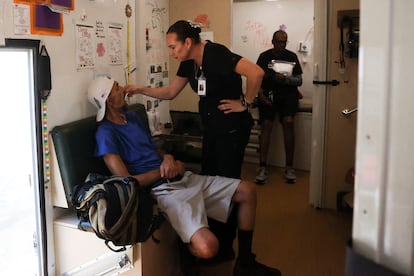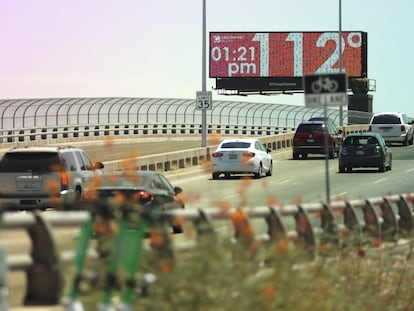As extreme heat continues in Phoenix, emergency rooms fill up with burn victims
Experts warn that the pavement is so hot that it only takes a few seconds for a person to get a third-degree burn. Last year, 257 people in the state of Arizona died from exposure to the high temperatures


The extreme heat in Arizona continues without respite. A record-breaking heat wave has turned the state’s capital, Phoenix, into an inferno. For the past 21 days, the temperature has been over 110 degrees Fahrenheit (43.3ºC) every single day. And on Monday, the thermometers hit 116.6ºF (47ºC). The extreme heat, compounded by tropical nights where the temperature does not fall below 86ºF (30ºC), has turned the city into an unlivable oven. And it will remain that way for at least another week. Meanwhile, the extreme heat is taking a toll on the health of residents, with emergency rooms in Phoenix hospitals filling up with burn victims.
In Phoenix, the fastest growing city in the United States, and the fifth-largest economy in the United States, the high temperatures have become dangerous to health. This is evidenced by data from the Arizona Burn Center in Valleywise Hospital, which shows how extreme heat has become a growing health problem. At the Arizona Burn Center, patients are coming in with increasingly complex wounds due to the heat. According to data from the center, between June and August 2022 as many as 85 people were admitted to the center for burns (26 of them homeless), and seven of them died from those injuries. And this year, the center’s 45 beds are at full capacity.
Among the symptoms presented last year were burns that covered between 5% to 23% of patients’ bodies, as well as hyperthermia and extreme body heat, which occurs when a person’s body temperature exceeds 107.6ºF (42ºC). The data reveal the scale of the injuries that can be caused by the extreme heat. The average stay for burn patients at the Arizona center was 16 days; one in three patients required intensive care, and of the 85 patients, 70% required assisted ventilation. According to the 2022 data, patients underwent an average of two surgeries, but one required as many as 18. Seven out of 10 patients required further care and had to be seen other specialists. One in four also required readmission to the hospital.
As the temperature continues to soar in the state, the director of the Arizona Burn Center, Kevin Foster, has called on the public to exercise extreme caution. In a blog post on the hospital’s website, Foster warned of the dangers posed by hot surfaces such as concrete and asphalt. “External surface temperatures can reach 180 degrees Fahrenheit, and deep cutaneous burns can happen with only brief contact,” Foster said. Such contact can cause painful injuries, especially for vulnerable patients such as the elderly, infants and children.

Last year, 257 people in the state of Arizona died from “exposure to excessive natural heat,” according to a Financial Times article on climate change, which showed that heat-related deaths have risen exponentially in the past few decades. Between 1990 and 2015, the average number of these deaths rose to 38.
Speaking to CNN, Foster said that summers are their “busy season,” and that they tend to have an idea of what to expect. “But this is really unusual — the number of patients that we’re seeing and the severity of injuries — the acuity of injuries is much higher,” he said. “The numbers are higher and the seriousness of injuries are higher, and we don’t have a good explanation for it.”
According to the doctor, half of the patients admitted to the ICU have serious burns just from falling on the ground. On a hot day, asphalt can easily be 40 to 60 degrees hotter than the air, according to some studies. “It’s just a little below boiling,” Foster said.
The doctor told CNN that it only takes “a fraction of a second” to get “a deep burn,” and that people who have been on the pavement for 10 to 20 minutes can suffer third-degree burns: “The skin is completely destroyed.”
This was confirmed by Dr. Frank LoVecchio, who also of the Arizona Burn Center. “Depending on where they are, if they have a knee on the asphalt and it is in the open sun, then it takes just minutes and unfortunately we’re seeing that quite often,” LoVecchio told CNN. “It only takes a few seconds for you to get a third-degree burn.”
He warned that the has treated people with reduced mobility who fell on the ground, patients who work outside in the heat and fainted, and homeless people sleeping on the pavement.
The meteorologist of the local Phoenix station Jeral Estupiñán told EL PAÍS that “when the body temperature rises above 37°C [98.6ºF], it overheats, and there can be permanent damage to the liver, brain…you have to avoid exposure to that heat, and drink lots of water.”
“People who live here think they are used to this heat, but just because you are used to it does not mean that your body is not affected by these temperatures,” added Estupiñán, who warned that in these conditions, “the ground becomes hotter than the air, especially in such urbanized areas.”
Caution is also needed with respect to pets. Dogs must only be taken for a walk when it is safe, explained María José Delgado, a member of the Veterinary Association of Córdoba in Spain. “Dogs cannot sweat to eliminate the heat as we humans do, so they pant to lower their temperature,” she said.
Dogs can also burn their skin and paws, just as humans can burn the soles of their feet. For this reason, dog owners must look for suitable place to go for a walk, wait for the temperatures to fall and even opt for protective boots.
Animals can also suffer from heat stroke, so they must never be locked up in places exposed to the sun, without ventilation or water, such as balconies and cars.
Sign up for our weekly newsletter to get more English-language news coverage from EL PAÍS USA Edition
Tu suscripción se está usando en otro dispositivo
¿Quieres añadir otro usuario a tu suscripción?
Si continúas leyendo en este dispositivo, no se podrá leer en el otro.
FlechaTu suscripción se está usando en otro dispositivo y solo puedes acceder a EL PAÍS desde un dispositivo a la vez.
Si quieres compartir tu cuenta, cambia tu suscripción a la modalidad Premium, así podrás añadir otro usuario. Cada uno accederá con su propia cuenta de email, lo que os permitirá personalizar vuestra experiencia en EL PAÍS.
¿Tienes una suscripción de empresa? Accede aquí para contratar más cuentas.
En el caso de no saber quién está usando tu cuenta, te recomendamos cambiar tu contraseña aquí.
Si decides continuar compartiendo tu cuenta, este mensaje se mostrará en tu dispositivo y en el de la otra persona que está usando tu cuenta de forma indefinida, afectando a tu experiencia de lectura. Puedes consultar aquí los términos y condiciones de la suscripción digital.
More information
Archived In
Últimas noticias
Trump claims peace in Ukraine is near, but Moscow suggests otherwise
A survivor’s account of the Interoceanic Train accident: ‘We were scared because of the speed on the curve’
The Interoceanic Train, the Mexican alternative to the Panama Canal
What is known about the Interoceanic Train derailment in Oaxaca
Most viewed
- Oona Chaplin: ‘I told James Cameron that I was living in a treehouse and starting a permaculture project with a friend’
- Reinhard Genzel, Nobel laureate in physics: ‘One-minute videos will never give you the truth’
- Why the price of coffee has skyrocketed: from Brazilian plantations to specialty coffee houses
- Pablo Escobar’s hippos: A serious environmental problem, 40 years on
- Chevy Chase, the beloved comedian who was a monster off camera: ‘Not everyone hated him, just the people who’ve worked with him’










































